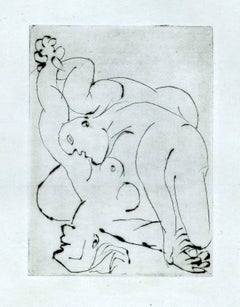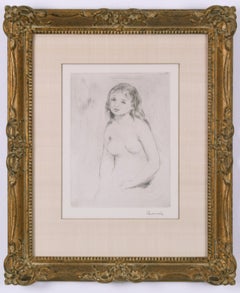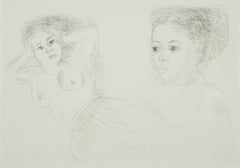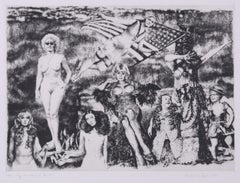Want more images or videos?
Request additional images or videos from the seller
1 of 5
Edward HagedornNude in Repose with Blanket
Price:$300
About the Item
- Creator:Edward Hagedorn (1902 - 1982, American)
- Dimensions:Height: 11 in (27.94 cm)Width: 15 in (38.1 cm)
- Medium:
- Period:
- Condition:
- Gallery Location:Fairlawn, OH
- Reference Number:Seller: FA67801stDibs: LU1402652321
About the Seller
5.0
Recognized Seller
These prestigious sellers are industry leaders and represent the highest echelon for item quality and design.
Platinum Seller
Premium sellers with a 4.7+ rating and 24-hour response times
Established in 1978
1stDibs seller since 2013
813 sales on 1stDibs
Associations
International Fine Print Dealers Association
Authenticity Guarantee
In the unlikely event there’s an issue with an item’s authenticity, contact us within 1 year for a full refund. DetailsMoney-Back Guarantee
If your item is not as described, is damaged in transit, or does not arrive, contact us within 7 days for a full refund. Details24-Hour Cancellation
You have a 24-hour grace period in which to reconsider your purchase, with no questions asked.Vetted Professional Sellers
Our world-class sellers must adhere to strict standards for service and quality, maintaining the integrity of our listings.Price-Match Guarantee
If you find that a seller listed the same item for a lower price elsewhere, we’ll match it.Trusted Global Delivery
Our best-in-class carrier network provides specialized shipping options worldwide, including custom delivery.You May Also Like
Incarnation 4. Young artist, Figurative print Linocut, Black & white, Polish art
By Luiza Kasprzyk
Located in Warsaw, PL
Black and white contemporary figurative linocut by Polish artist Luiza Kasprzyk. Artwork comes from limited edition of 50. Print depicts bodies permeating each other.
LUIZA KASPRZY...
Category
2010s Contemporary Figurative Prints
Materials
Paper, Linocut
Reclining Nude
By Irene Zevon
Located in Buffalo, NY
An original linocut print by American artist Irene Zevon. The reclining nude is one of Zevon's most coveted subject matters. This 1959 print is one of a series of ten prints.
Category
1950s American Modern Figurative Prints
Materials
Linocut, Paper
Femme Couchée et Homme au Grand Chapeau
By Pablo Picasso
Located in New York, NY
Large, attractive color linocut by Pablo Picasso from a limited edition of 50. Signed by Picasso and numbered in pencil. Printed by Arnéra, Vallaur...
Category
1950s Modern Figurative Prints
Materials
Linocut, Color
$28,000 Sale Price
37% Off
H 21 in W 25.38 in
"Encuentro" 2006 Original Unique Signed Artist Proof 28x20in Woodcut Mexican
By Antonio Díaz Cortés
Located in Miami, FL
Antonio Diaz Cortes (Mexico, 1935)
'Encuentro' (meeting), 2006
woodcut on paper Velin Arches 300 g.
27.6 x 19.7 in. (70 x 50 cm.)
P/A (Artist Proof), unique piece
Unframed
ID: DIA-10...
Category
Early 2000s Contemporary Nude Prints
Materials
Engraving, Woodcut, Ink, Linocut
'Reclining Nude', Cabinet-Sized Post-Impressionist Figural
By Wedo Georgetti
Located in Santa Cruz, CA
A hand-colored linocut created circa 1950 by Wedo Georgetti (American, 1911-2005) and stamped verso with Certification of Authenticity.
Born in Italy, this California Post-Impressio...
Category
1950s Figurative Prints
Materials
Paper, Crayon, Linocut
$950
H 5 in W 12.25 in
Orchis 2, by Wuon-Gean Ho
By Wuon-Gean Ho
Located in Palm Springs, CA
This is from a series of linocuts made with a single horizontal line. The resulting mesh of black and white creates a shimmering effect that both defines and blurs the image. Object...
Category
2010s Nude Prints
Materials
Linocut
Orchis 6, by Wuon-Gean Ho
By Wuon-Gean Ho
Located in Palm Springs, CA
This is from a series of linocuts made with a single horizontal line. The resulting mesh of black and white creates a shimmering effect that both defines and blurs the image. Objects...
Category
2010s Nude Prints
Materials
Linocut
Hillbilly Kama Sutra, Collection of 13 Linoleum Cut Prints by Master Printmaker
By Tom Huck
Located in Chicago, IL
This is an extraordinary collection of Linoleum Cuts by master printmaker Tom Huck. The Suite of 13 linocuts is encased in a homemade glory hole cover and also include a protective centerfold cover. This artwork could be framed to hang in a grouping. Contact gallery for details.
Tom Huck, also spelled Hück, (born 1971), is an American printmaker best known for his large-scale satirical woodcuts. He lives and works in St. Louis, Missouri, where he runs his own press, Evil Prints. He is a regular contributor to BLAB! of Fantagraphics Books. His work is influenced by Albrecht Dürer, José Guadalupe Posada, R. Crumb, and Honoré Daumier. Huck’s illustrations have appeared in publications such as The Village Voice, The Riverfront Times, and the Minneapolis City Pages.
Huck's woodcut prints are included in numerous public and private collections, including the Whitney Museum of American Art, Library of Congress, Spencer Museum of Art, Nelson Atkins Museum of Art, Saint Louis Art Museum, Milwaukee Art Museum, Minneapolis Institute of Art, Art Institute of Chicago, Fogg Art Museum, Michael C. Carlos Museum, and New York Public Library. Huck has been represented by David Krut Art Projects in New York, Sherry Leedy Contemporary Art in Kansas City, Missouri, Duane Reed Gallery in St. Louis, Missouri, Gallery Victor Armendariz, Chicago and Eli Ridgway Gallery in San Francisco. Beginning in October 2017 Huck’s gallery representation is C. G. Boerner in New York.
In September 2011 Huck was awarded a Pollock-Krasner Foundation grant.
Huck is best known for creating large-scale woodcuts acting as both satirical narratives and social criticism.[1] He says in his artist statement: "My work deals with personal observations about the experiences of living in a small town in southeast Missouri. The often Strange and Humorous occurrences, places, and people in these towns offer a never-ending source of inspiration for my prints. I call this work 'rural satire'".[2]
From 1995 to 2005, Huck created two woodcut folios: 2 Weeks in August: 14 Rural Absurdities and The Bloody Bucket. 2 Weeks in August: 14 Rural Absurdities, a thematically unified suite of 14 large woodcut prints, depicted 14 bizarre folk tales that allegedly occurred in Huck's hometown of Potosi, Missouri. The suite was produced in three years from 1995 to 1998. His second body of work, The Bloody Bucket, was based on violent legends surrounding a bar of that name in or around his hometown of Potosi. It comprises 10 large-scale woodcuts, executed between 1999 and 2005.
In December 1999, Huck's work represented the United States in an exhibition entitled From Kandinsky To Corneille: Linoleum in the Art of the 20th Century held at the Cobra Museum in Amstelveen, Holland. Featured in the exhibition was a large scale linoleum cut by Huck entitled "Attack of the 50ft. Yard Ornament". The piece was commissioned specifically for the exhibition by the linoleum company Forbo-Krommenie in Amsterdam.
The Whitney Museum of American Art in September 2003 featured two works by Huck in an exhibition entitled To Be Human. Both the works featured were woodcuts from the series 2 Weeks in August.
Huck is currently working on a 14-triptych cycle of woodcut prints entitled Booger Stew. The first installment of the series, a triptych entitled "The Transformation of Brandy Baghead Pts. 1, 2, & 3", was completed in March 2009. An exhibition entitled Tom Huck and the Rebellious Tradition of Printmaking opened on August 28, 2009 at the Saint Louis Art Museum. Prints by Albrecht Dürer, William Hogarth, Jose Guadalupe Posada, and Max Beckmann were featured alongside Huck's "The Transformation of Brandy Baghead Pts. 1, 2, & 3".
Electric Baloneyland
On December 19, 2011, Huck announced the April 1, 2012, release of The Hillbilly Kama Sutra. This new suite of 15 linoleum cut prints is Huck's first portfolio of prints since 1998's 2 Weeks in August: 14 Rural Absurdities. On April 12, 2012, a selection of prints from the new series were released in the St. Louis weekly publication The Riverfront Times. On May 4, 2012, Sherry Leedy Contemporary Art in Kansas City, Missouri, hosted the debut exhibition of The Hillbilly Kama Sutra.
In February 2013, Huck illustrated a cover story entitled "The 10 Weirdest Members of Congress" written by Caleb Hannan. The feature article appeared in The Riverfront Times and four other Voice Media Group publications: the Houston Press, Dallas Observer, Broward-Palm Beach New Times, and Minneapolis City Pages. All five had a cover caricature of Michele Bachmann's head on a snake, referencing the "Don't Tread On Me" motif. The story featured 9 politicians in caricature.
In early spring of 2014 Huck completed work on his second major woodcut triptych from "Booger Stew" entitled "The Tommy Peeperz". "The Tommy Peeperz" debuted in a show of The Outlaw Printmakers entitled "The Dirty Dozen...
Category
21st Century and Contemporary Contemporary Figurative Prints
Materials
Linocut
$15,000
H 15 in W 15 in
She Did Not Hurry, female figurative Linocut original print, Unframed
By Ellen Von Wiegand
Located in Dallas, TX
"She Did Not Hurry" is an original linocut on Kozuke paper by Ellen Von Wiegand.
Image size 23.75 x 15.75 inches / 60 x 40 cm
Paper size 30 x 20 inches / 76 x 50 cm
Von Wiegand typi...
Category
2010s Contemporary Figurative Prints
Materials
Linocut, Ink
$680 Sale Price
20% Off
H 30 in W 20 in
Wanting Solitude and Closeness, female nude, Linocut original print, Unframed
By Ellen Von Wiegand
Located in Dallas, TX
"Wanting Solitude and Closeness" is an original linocut on Kozuke paper by Ellen Von Wiegand.
Image size 23.75 x 15.75 inches / 60 x 40 cm
Paper size 30 x 20 inches / 76 x 50 cm
Thi...
Category
2010s Contemporary Figurative Prints
Materials
Linocut, Handmade Paper, Ink
More From This Seller
View AllLe Voil, I
By Pablo Picasso
Located in Fairlawn, OH
Provenance:
Marina Picasso Estate, her number verso
Purchased from Jan Krugier Gallery, NY
References And Exhibitions:
Georges Bloch, Picasso: Catalogue de l'oeuvre grave et lith...
Category
1930s Nude Prints
Materials
Drypoint
Etude pour une baigneuse (Study for a Bather)
By Pierre Auguste Renoir
Located in Fairlawn, OH
Etude pour une baigneuse (Study for a Bather)
Drypoint, 1901-1911
Signed with the signature stamp, Lugt 2137a
Printed: Louis Fort, Paris
Publisher: Ambrose Vollard, Paris
"The fame o...
Category
Early 1900s Impressionist Nude Prints
Materials
Drypoint
Deux Antillaise (Deux Négresses)
By Raoul Dufy
Located in Fairlawn, OH
Deux Antillaise (Deux Négresses)
Edition: Proof on Van Gelder paper
Unsigned (as usual for this image)
Edition: unknown
Published by Ambrose Vollard, Paris (?)
References: Johnson 25...
Category
1920s French School Prints and Multiples
Materials
Etching
My Bicentennial Print
By Herbert L. Fink
Located in Fairlawn, OH
My Bicentennial Print
Photo etching, 1976
Signed and dated in pencil lower right (see photo)
Titled and numbered in pencil loer left (see photo)
Edition: 21 (16/21) There also appears to be an additon of 100.
Condition: Excellent
Image/Plate size: 14 1/2 x 19 3/4 inches
Sheet size: 22 1/8 X 30 inches
The artist's commentrary on the Bicentennial Year of 1976
In 1965 Fink was awarded a Gugenheim Memorial Foundation Fellowship for Fine Arts.
Herbert Lewis Fink, painter, printmaker, sculptor, and educator, born was in Providence, Rhode Island on September 8, 1921. He studied at the Carnegie Institute of Technology in 1941, he received is B.F.A. degree from the Rhode Island School of Design in 1949, his M.F.A. from Yale University in 1956, and he also studied for a year at the Art Students League and with John Frazier...
Category
1970s Contemporary Nude Prints
Materials
Etching
In the Wood
By Gerald Leslie Brockhurst
Located in Fairlawn, OH
Etching, 1920
Signed in pencil
Edition: 110 examples
Very fine condition
Provenance: Colnaghi, London (stock numbers on reverse)
The artist'w widow, Dorette, 19...
Category
1920s Pre-Raphaelite Nude Prints
Materials
Etching
La Pierre aux Trois Croquis
By Pierre-Auguste Renoir
Located in Fairlawn, OH
La Pierre aux Trois Croquis
From: Douze lithographies originales de Pierre-Auguste Renoir
Publisher: Ambrose Vollard
Edition: 950 (signed in the stone) on wove paper as here (see pho...
Category
Early 1900s Impressionist Prints and Multiples
Materials
Lithograph



